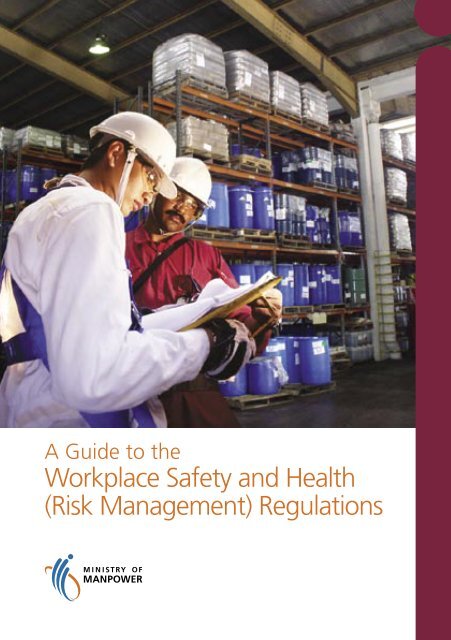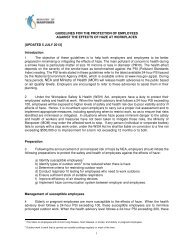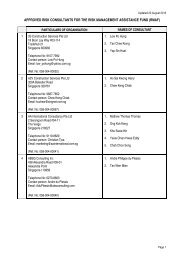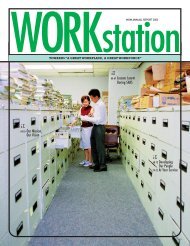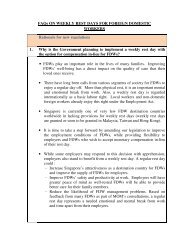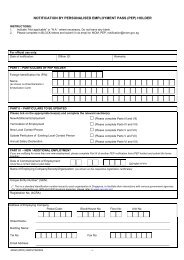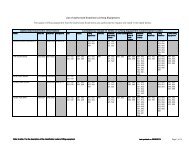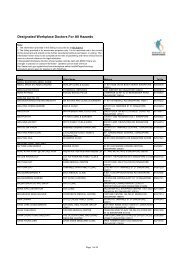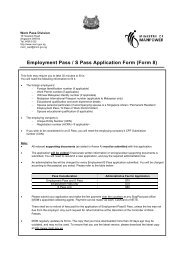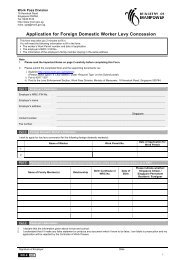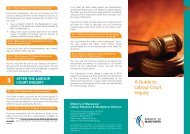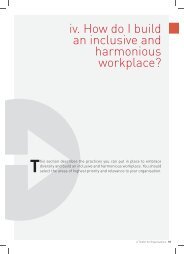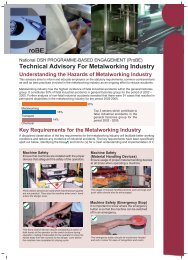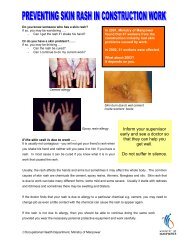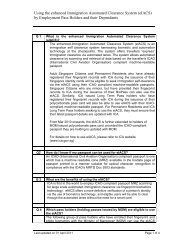Workplace Safety and Health (Risk Management) - Ministry of ...
Workplace Safety and Health (Risk Management) - Ministry of ...
Workplace Safety and Health (Risk Management) - Ministry of ...
Create successful ePaper yourself
Turn your PDF publications into a flip-book with our unique Google optimized e-Paper software.
A Guide to the<br />
<strong>Workplace</strong> <strong>Safety</strong> <strong>and</strong> <strong>Health</strong><br />
(<strong>Risk</strong> <strong>Management</strong>) Regulations
Contents<br />
Introduction 2<br />
<strong>Workplace</strong> <strong>Safety</strong> <strong>and</strong> <strong>Health</strong><br />
(<strong>Risk</strong> <strong>Management</strong>) Regulations<br />
- Why is there a need for the <strong>Workplace</strong> <strong>Safety</strong><br />
<strong>and</strong> <strong>Health</strong> (<strong>Risk</strong> <strong>Management</strong>) Regulations? 3<br />
- What is a hazard? 3<br />
- What is a risk? 3<br />
- What is the difference between risk<br />
assessment <strong>and</strong> risk management? 4<br />
- Who needs to conduct risk assessment? 4<br />
- How should this risk assessment be conducted? 4<br />
- What can be done to control risks in the<br />
workplace? 4<br />
- If the risk cannot be eliminated, how should<br />
safe work procedures be implemented? 5<br />
- How <strong>of</strong>ten must the risk assessment be<br />
reviewed? 6<br />
- How should risk assessment records be<br />
maintained? 6<br />
- What steps should the taken to communicate<br />
the risks involved? 6<br />
- What are the <strong>of</strong>fences <strong>and</strong> penalties<br />
related to the <strong>Workplace</strong> <strong>Safety</strong> <strong>and</strong> <strong>Health</strong><br />
(<strong>Risk</strong> <strong>Management</strong>) Regulations? 7<br />
- Further information 8<br />
1
2<br />
Introduction<br />
In 2005, the <strong>Ministry</strong> <strong>of</strong> Manpower unveiled a new<br />
occupational safety <strong>and</strong> health framework to make possible<br />
quantum improvements in safety <strong>and</strong> health st<strong>and</strong>ards at<br />
the workplace. An underpinning principle under the new<br />
framework is to eliminate or mitigate safety <strong>and</strong> health<br />
risks at source.<br />
The risk associated with any work activity depends on the<br />
severity <strong>of</strong> an accident or ill health that may occur, <strong>and</strong><br />
the likelihood <strong>of</strong> its occurrence. All risks at work can be<br />
controlled, <strong>and</strong> all accidents or ill health can be prevented.<br />
Some methods <strong>of</strong> control are better than others in a<br />
given situation. Some risks require more than one control<br />
method to achieve optimum results. Whatever risk control<br />
measures we take, the aim is to reduce the likelihood <strong>of</strong><br />
occurrence <strong>and</strong>/or the severity <strong>of</strong> the accident or ill health.<br />
Ultimately, the risk must be reduced to an acceptable level<br />
before commencement <strong>of</strong> work.<br />
<strong>Risk</strong> management is a process by which the management<br />
assesses the risks, determines the control measures, <strong>and</strong><br />
takes appropriate actions to reduce such risks. It is a<br />
cornerstone to prevent deaths, injuries <strong>and</strong> ill health at<br />
work. All workplaces need to conduct risk assessments<br />
to help identify the source <strong>of</strong> risks, actions that should be<br />
taken, <strong>and</strong> parties responsible for doing so.<br />
With the emphasis to reduce risk at the workplace, the<br />
new <strong>Workplace</strong> <strong>Safety</strong> <strong>and</strong> <strong>Health</strong> (<strong>Risk</strong> <strong>Management</strong>)<br />
Regulations detail the steps required to eliminate risk or<br />
reduce it to as low as is reasonably practicable.<br />
This booklet provides guidance to the Regulations which<br />
come into operation on 1 September 2006.
(<strong>Risk</strong> <strong>Management</strong>)<br />
A Guide to the <strong>Workplace</strong><br />
<strong>Safety</strong> <strong>and</strong> <strong>Health</strong><br />
Regulations<br />
Why is there a need for the <strong>Workplace</strong> <strong>Safety</strong> <strong>and</strong><br />
<strong>Health</strong> (<strong>Risk</strong> <strong>Management</strong>) Regulations?<br />
In the new framework for occupational safety <strong>and</strong> health<br />
in Singapore, one <strong>of</strong> the major means <strong>of</strong> reducing risks at<br />
the workplace is by making stakeholders accountable for<br />
managing the risks they create. <strong>Risk</strong> assessment is a key<br />
instrument to reduce risk at the workplace.<br />
Employers, self-employed persons <strong>and</strong> principals (including<br />
contractors <strong>and</strong> sub-contractors) have the responsibility<br />
<strong>of</strong> identifying safety <strong>and</strong> health hazards at the workplace<br />
<strong>and</strong> taking appropriate actions to eliminate the hazards<br />
or reduce the risks associated with the hazards. These<br />
requirements are specified in the <strong>Workplace</strong> <strong>Safety</strong> <strong>and</strong><br />
<strong>Health</strong> (<strong>Risk</strong> <strong>Management</strong>) Regulations.<br />
What is a hazard?<br />
A ‘hazard’ is something that in itself may cause harm<br />
or injury. <strong>Workplace</strong> hazards include moving parts <strong>of</strong><br />
machinery, working at heights, slippery floors, electric<br />
energy, excessive noise, toxic or flammable substances, <strong>and</strong><br />
lifting heavy objects.<br />
What is a risk?<br />
A ‘risk’ means the likelihood that a hazard will cause a<br />
specific harm or injury to persons or damage to property.<br />
For example, if a person works at a 40 metre height on a<br />
platform without any railing <strong>and</strong> safety harness, the risk <strong>of</strong><br />
falling <strong>and</strong> getting killed is high.<br />
3
4<br />
What is the difference between risk assessment <strong>and</strong><br />
risk management?<br />
<strong>Risk</strong> assessment is the process <strong>of</strong> identifying safety <strong>and</strong><br />
health hazards associated with work, assessing the level<br />
<strong>of</strong> risks involved, <strong>and</strong> prioritizing measures to control the<br />
hazards <strong>and</strong> reduce the risks.<br />
<strong>Risk</strong> management, like risk assessment, involves<br />
assessment <strong>of</strong> risks associated with any work activity or<br />
trade. However, it also includes control <strong>and</strong> monitoring <strong>of</strong><br />
such risks, as well as communicating these risks.<br />
Who needs to conduct risk assessment?<br />
Every employer, self-employed person <strong>and</strong> principal<br />
(including contractor <strong>and</strong> sub-contractor) must conduct<br />
a risk assessment in relation to the safety <strong>and</strong> health<br />
hazards associated with any routine <strong>and</strong> non-routine work<br />
carried on at the workplace. The risk assessment may be<br />
conducted by the employers, self-employed persons or<br />
principals themselves or they may engage a risk assessment<br />
consultant to carry out the risk assessment.<br />
How should this risk assessment be conducted?<br />
Details <strong>of</strong> how risk assessment is to be conducted can be<br />
found in the <strong>Ministry</strong> <strong>of</strong> Manpower Guidelines on <strong>Risk</strong><br />
Assessment. Please access the following website for the<br />
Guidelines:<br />
http://www.mom.gov.sg/OSHD/Resources/Guides/<br />
Guidelines/index.htm<br />
What can be done to control risks at the workplace?<br />
Every employer, self-employed person <strong>and</strong> principal<br />
(including contractor <strong>and</strong> sub-contractor) must take<br />
all reasonably practicable measures to eliminate any
foreseeable risk to any person who may be affected by<br />
their undertaking.<br />
If the risk cannot be eliminated, the employer, selfemployed<br />
person <strong>and</strong> principal (including contractor <strong>and</strong><br />
sub-contractor) must take reasonably practicable measures<br />
to minimise the risk. Some measures to minimise risks<br />
are listed below. They are listed in decreasing order <strong>of</strong><br />
preference, i.e. from most preferred to least preferred.<br />
1. Substitution e.g. substituting a hazardous substance or<br />
process with a less hazardous one<br />
2. Engineering controls e.g. installing machine guarding<br />
or enclosing a noisy machine<br />
3. Administrative controls e.g. implementing a permit-towork<br />
system or lock-out <strong>and</strong> tag-out procedures<br />
4. Provision <strong>and</strong> use <strong>of</strong> suitable personal protective<br />
equipment<br />
In addition, safe work procedures must be implemented to<br />
control the risk.<br />
If the risk cannot be eliminated, how should safe<br />
work procedures be implemented?<br />
If the risk cannot be eliminated, every employer, selfemployed<br />
person <strong>and</strong> principal (including contractor <strong>and</strong><br />
sub-contractor) must establish safe work procedures to<br />
minimise the risk. Safe work procedures are step-bystep<br />
measures <strong>of</strong> doing or carrying out work safely. The<br />
procedures must include the measures to be taken to<br />
safeguard persons in the event <strong>of</strong> an emergency. The safe<br />
work procedure must be communicated to the worker.<br />
Every employer, self-employed person or principal must<br />
specify the roles <strong>and</strong> responsibilities <strong>of</strong> persons involved in<br />
the implementation <strong>of</strong> the risk control measures <strong>and</strong> safe<br />
work procedures.<br />
5
6<br />
How <strong>of</strong>ten must the risk assessment be reviewed?<br />
The risk assessment must be reviewed or revised at least<br />
once every 3 years.<br />
It must also be reviewed in the event <strong>of</strong> the following:<br />
• After an accident as a result <strong>of</strong> exposure to a hazard,<br />
• When there is a significant change in work<br />
processes that could affect the safety <strong>and</strong><br />
health <strong>of</strong> the workers, for example, the<br />
introduction <strong>of</strong> new machinery or chemicals.<br />
How should risk assessment records be maintained?<br />
A record <strong>of</strong> risk assessments conducted must be maintained.<br />
The record should include:<br />
• the results or findings recorded in<br />
risk assessment forms,<br />
• risk control measures taken or to be taken,<br />
• any safe work procedures.<br />
The record must be kept by the employer, self-employed<br />
person or principal (including contractor <strong>and</strong> sub-contractor)<br />
for at least 3 years.<br />
What steps should the taken to communicate the<br />
risks involved?<br />
Every employer, self-employed person <strong>and</strong> principal<br />
(including contractor <strong>and</strong> sub-contractor) must take all<br />
reasonably practicable steps to inform his employees or any<br />
other persons at the workplace who may be exposed to<br />
safety <strong>and</strong> health risk.<br />
They should be informed <strong>of</strong> the following:<br />
• the nature <strong>of</strong> the risk involved,<br />
• the measures implemented to control the risk,
• applicable safe work procedures.<br />
Whenever the risk assessment is revised, or when there is<br />
a significant change in work practices or procedures, the<br />
employees or other persons who may be at risk must be<br />
informed accordingly.<br />
What are the <strong>of</strong>fences <strong>and</strong> penalties related to the<br />
<strong>Workplace</strong> <strong>Safety</strong> <strong>and</strong> <strong>Health</strong> (<strong>Risk</strong> <strong>Management</strong>)<br />
Regulations?<br />
Any employer, self-employed person or principal (including<br />
contractor <strong>and</strong> sub-contractor) who fails to comply with the<br />
following requirements <strong>of</strong> the <strong>Workplace</strong> <strong>Safety</strong> <strong>and</strong> <strong>Health</strong><br />
(<strong>Risk</strong> <strong>Management</strong>) Regulations is guilty <strong>of</strong> an <strong>of</strong>fence:<br />
• Conduct a risk assessment for all<br />
work in the workplace.<br />
• Take reasonably practicable measures to<br />
eliminate or reduce safety <strong>and</strong> health risks.<br />
• Establish safe work procedures if the<br />
risks cannot be eliminated.<br />
• Specify the roles <strong>and</strong> responsibilities <strong>of</strong> persons<br />
involved in the implementation <strong>of</strong> risk control<br />
measures <strong>and</strong> safe work procedures.<br />
• Keep records <strong>of</strong> risk assessment.<br />
• Inform employees <strong>of</strong> the nature <strong>of</strong> the risks<br />
involved <strong>and</strong> any risk control measures or<br />
safe work procedures implemented.<br />
• Review or revise risk assessment.<br />
The penalty for the first <strong>of</strong>fence is a fine <strong>of</strong> up to $10,000.<br />
For a second or subsequent <strong>of</strong>fence, the <strong>of</strong>fender may be<br />
fined up to $20,000 or jailed up to 6 months or both.<br />
7
8<br />
Under the <strong>Workplace</strong> <strong>Safety</strong> <strong>and</strong> <strong>Health</strong> Act, the<br />
Commissioner for <strong>Workplace</strong> <strong>Safety</strong> <strong>and</strong> <strong>Health</strong> may<br />
issue a Remedial Order to require an employer or<br />
any other person to remove any workplace risk or to<br />
comply with a safe work procedure. Failure to comply<br />
with a Remedial Order is considered an <strong>of</strong>fence <strong>and</strong><br />
the maximum fine for the <strong>of</strong>fence is $50,000 or 12<br />
months imprisonment or both.<br />
Further information<br />
For worked examples <strong>of</strong> risk assessment <strong>and</strong> templates for<br />
risk assessment, please visit our website at:<br />
http://www.mom.gov.sg/OSHD/Resources/Guides/<br />
Guidelines/index.htm<br />
Compiled by <strong>Ministry</strong> <strong>of</strong> Manpower<br />
May 2006
<strong>Ministry</strong> <strong>of</strong> Manpower<br />
Occupational <strong>Safety</strong> <strong>and</strong> <strong>Health</strong> Division<br />
18 Havelock Road #03-02<br />
Singapore 059764<br />
Tel (65) 64385122<br />
Fax (65) 63171261<br />
www.mom.gov.sg<br />
mom_oshd@mom.gov.sg


